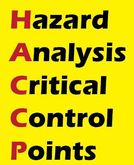11/20/2014
Vol. 18, Issue 4
Food Digest is a quarterly newsletter written by inspectors from your local health department to support and educate Hennepin County food facility owners and managers about food safety as recommended by Minnesota Food Code 4626.

We welcome comments or ideas about our newsletter.
Amy Zagar
612-543-5267
Hannah Marschinke
612-543-5255
|
Hennepin County Public Health Protection is thrilled to welcome three new Environmental Health Specialists!
 Introducing Patrick Kuisle, one of Hennepin County’s most recently hired Environmental Health Specialists. Originally from Rochester, Minnesota, Patrick obtained a Bachelor of Arts in Biology from St. John’s University in 2005 and went on to do quality assurance and regulatory affairs for ProtaTek International, a USDA-licensed animal health firm in St. Paul. In 2013, while completing a work visa, Patrick worked on the pasteurizer and bottling line for Stoke Brewery in Nelson, New Zealand.
Patrick joined the Environmental Health team in September 2014. As an Environmentalist/Sanitarian, his primary duties are food, lodging and pool inspections. Patrick is also a potter, musician, cyclist, brewer and community food share organizer.
|
 Meet former intern, Aaron Arvold!
Aaron was an intern for Hennepin County Environmental Health Unit during the summer of 2014. In 2013, he graduated from the University Of Minnesota with a degree in Environment Science. Aaron officially joined as and Environmental Health Specialist in November 2014.
As an Environmentalist/Sanitarian, his primary duties are food, lodging and pool inspections. In his free time, he likes to snowboard, play hockey, play Frisbee, go to concerts and music festivals, or just relax with his friends.
|
 Welcome Opeyemi Adesida! Opey worked previously as an Environmental Technician for City of Brooklyn Park Code Enforcement and Public Health Unit during the summer of 2014. She graduated in May 2014, from the University Of Minnesota school of Public Health with a Master’s degree in Public Health with an emphasis in Environmental Infectious Diseases. She obtained a Bachelor of Science degree in Medicine and Surgery from Lagos State University College of Medicine in Lagos Nigeria and practiced as a physician for three years in Nigeria. Opey started with Hennepin County November 17th 2014. In her spare time, Opey loves to hang out with her two year old, watch movies, relax with family and occasionally read a book.
|
 By Pam Foster
Have you ever seen the late night infomercial showing a vacuum sealing machine used to keep foods fresh? You think it might help with the losses at your restaurant kitchen if you could just do a little something extra and it is just a quick phone call away.
But wait, there's more! In a commercial facility, there is more food safety procedures required for reduced oxygen packaging (ROP) than there appears to be shown in the deal that is tempting you on the TV.
In a licensed kitchen facility, all equipment must be commercial and tested to equipment standards, such as the National Sanitation Foundation (NSF) standards. This piece of information, alone, just saved you from boxing up and returning the domestic vacuum sealing machine you may have ordered from the advertisement.
|
|
|
It is also important to know that when a vacuum is pulled on a food package and the oxygen level is reduced, it can create a dangerous process that can allow for the potential growth of Clostridium botulinum. This organism grows in an oxygen-free atmosphere, which creates botulinum toxin, one of the deadliest toxins known to man.
Clostridium botulinum a.k.a, C. bot produces the toxin that causes botulism, which can lead to paralysis or even death.**
|
To do this process in a commercial kitchen, a variance from the MN Food Code Section 4626.0420, item B, subitem (2), is required and an approved Hazard Analysis Critical Control Point (HACCP) plan must be in place, along with a commercial vacuum packaging machine.
The reduced oxygen HACCP plan identifies critical control steps during the process that are measured, recorded, monitored and also lists the corrective action(s) needed if the critical limits are not met. It creates a safety control measure for the process to ensure that the potential for growth of C. botulinum does not occur. Once the plan is approved and the variance granted, an additional audit fee is added to your annual food license to cover the time needed to conduct an audit of your HACCP plan and records on an annual basis, separate from the routine inspection of your facility.
 Besides reduced oxygen packaging, there are a few other processes that require a variance and an approved HACCP plan which include: curing or smoking foods for preservation (not flavor); additives to render a food non-potentially hazardous, such as adding vinegar to rice for sushi; if more than one tagged shellstock container is in use at a time; use of molluscan shellfish life-support system display tanks; and any deviation from required cooking times and temperatures for raw animal food, such as in sous vide cooking.*
It is recommended that a consultant knowledgeable in HACCP plan development review and assist in the preparation of your plan. Courses are offered through the University of Minnesota extension program, as well as, many online resources. HACCP planning information is in the FDA Food Code Annex 5: HACCP Guidelines and Annex 6: Food Processing Criteria.
If you have any questions or would like to obtain our variance form and a HACCP application, please contact our office at 612-543-5200 or use our link at www.hennepin.us/envhealth. Click on “Applications” and fill out both HACCP Plan and HACCP Variance forms. or use our link at www.hennepin.us/envhealth. Click on “Applications” and fill out both HACCP Plan and HACCP Variance forms.
|
*(Note: There are other processes that require HACCP plans such as juice and cider production. Best practice is to consult your Health Authority and discuss the process prior to implementing it).
**Learn more about botulism from the Centers for Disease Control and Prevention (CDC).
General Environmental Health information
www.hennepin.us/envhealth
Basic Food Safety Class information
www.hennepin.us/foodclass
Temporary Food Stand Licensing
www.hennepin.us/itinerant
Food License information, categories and fee schedule
www.hennepin.us/foodlicense
New Construction or Remodeling application
www.hennepin.us/planreview
Radon information and test kits
www.hennepin.us/radon
Septic System requirements and procedures
www.hennepin.us/septic
Body Art Licensing information (tattooing and piercing)
www.hennepin.us/bodyart
Beaches in Hennepin County
www.hennepin.us/beaches
|